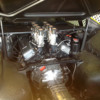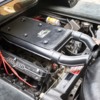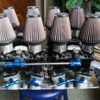After years of repeatedly installing and uninstalling my webers I have finally succeeded to get them running very well. With the help of forum member suggestions, internet discussions and Jim Ingleese pep talks and jets it wants to fly. Problems were probably made worse by attempting to pull vacuum of one of the carbs to power the brakes. Now an electric vacuum pump handles that. One issue remains. I drive the car an average of 750 miles a year. Is there any point in using air filters? Currently the stacks are protected by clip-on screens.
Attachments
Original Post




